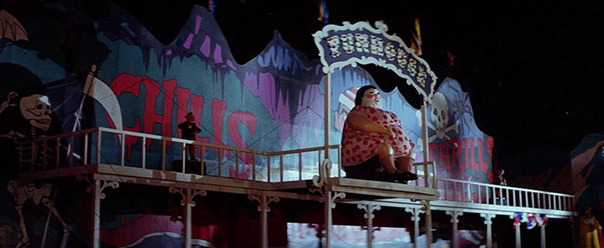Reflecting on Tobe Hooper and "The Funhouse"
I have been and no doubt always will be a horror film buff.
By the time I entered elementary school, I had taken in all of the old Universal monster movies (remember that epic collection the studio released in the early '90s?) and was well on my way to the bolder likes of the Halloween, Friday the 13th and Child's Play franchises.
Around this time, my family must've made at least one, maybe two weekly stops to a local video shop.
There was Blockbuster Video, of course, but even better was Banana Video, a mom and pop (actually, I think it was a mom and son) shop that was smaller than Blockbuster but sported a far more intriguing and idiosyncratic VHS collection - the likes of Killer Klowns from Outer Space and Return of the Killer Tomatoes were favorites of mine that Banana carried and Blockbuster inexplicably didn't. I rented those two and entries from the Critters and Gremlins series over and over again, as my mom wasn't quite yet ready to rent out for me classics like Black Christmas and Terror Train.
You cannot imagine how much I wanted my parents to rent this for me.
Well, one picture I always wanted to rent but wasn't allowed to was The Funhouse, Tobe Hooper's first post-Texas Chainsaw film for a major studio. (Quick plot summary for those who haven't seen the film: a quartet of teenagers spend the night in a carnival funhouse, steal some money from the carnival barker and are chased around by the barker's deformed son, who dons a Frankenstein monster mask and has no qualms about making mincemeat of them.) I was head-over-heels for the VHS cover - an axe-wielding clown emerging from a jack-in-the-box. That it took place in a carnival (I was already enamored with all things theme park) made me all the more hungry to at last see this thing.
Relegated to nothing more extreme than the PG-13 options, I would eagerly open up the local paper's TV guide every Sunday morning to see if The Funhouse was to surface on cable sometime over the coming week. For the longest time, it never did (I never caught Joe Bob Briggs' MonsterVision treatment of it on TNT) and then suddenly, out of the blue, it was scheduled to air...on none other than A&E, on a Saturday afternoon (thank heavens, not during school).
I think we were supposed to go out for a family hike but somehow, I managed to convince my parents to forgo that so I could plop in front of the tube and watch what would no doubt be a Citizen Kane-level masterpiece in cinema. And, you know what...I did love it. Madly. And my parents too were fond of it, so much so they rented out the unedited VHS for me not long down the road.
The latter half of The Funhouse is packed with sumptuously shot, genuinely terrifying scenes like this one.
Over the years to follow, I would make it a mission to catch The Funhouse every single time (which admittedly wasn't very many) it graced cable. By high school, I owned it on VHS and then of course grabbed the DVD as soon as it received that treatment. I'm still enamored with the film, warts and all (of which there are more than a few), to this day.
So, as you can imagine, my heart sank at the news that Hooper, one of the all-time great masters of horror (right up there with the likes of Argento, Brown, Carpenter, Craven, Romero and Whale), died on August 26 at the age of 74.
For years, I had so much hoped, perhaps more for him than any other filmmaker, that Hooper could somehow reemerge and score a big comeback, whether on the big screen or small screen.
The Texas Chainsaw Massacre, Poltergeist, Lifeforce and even his remake of Invaders from Mars are all among my very favorite horror/sci-fi pictures, annual must-sees that I'll no doubt be devouring closer to Halloween. That his career all but turned to dust after 1986 (when his three-pic deal with the hacks over at The Cannon Group ended) has long perplexed and saddened me. I sure have been comforted, however, by the celebration of his filmography in the hours since his passing.
One Hooper flick that hasn't been quite as name-dropped as others in his filmography is none other than The Funhouse, a picture that, despite my love and affection for it, remains something of an obscurity, even among die-hard slasher movie fans.
The common criticism I've come across with The Funhouse is the picture takes too long to get going, that there's far too much exposition on the film's horny teenagers (Elizabeth Berridge's Liz, Cooper Huckabee's Buzz, Largo Woodruff's Amy and Miles Chapin's Richie) before they finally make the decision, about a third of the way into the proceedings, to spend the evening in the creepy funhouse.
I for one, however, adore the film from start to finish.
Two-time Oscar nominee Sylvia Miles!
Unlike the bulk of the Halloween knockoffs from the early '80s, Hooper's film, written by Larry Block, aims to make us give a genuine shit about its characters, so yeah, there isn't blood and guts oozing from the screen from the opening frame. We actually get to know Berridge's Amy, her friends and her brother (Shawn Carson). We're also, later into the picture, treated to great, dialogue-heavy scenes involving the funhouse barker (Kevin Conway, in a fabulously slimy and scary performance), his deformed son (Wayne Zoba) and the deliciously trashy Madame Zena (the one and only, twice-Oscar-nominated Sylvia Miles). So, kudos to Block for not doing a lazy copy-and-paste from prior slasher flicks, as all too many were doing around this time.
While Block's script is a solid one and the film is all-around impressive from the technical perspective - marvelous cinematography by Andrew Laszlo (in his follow up to The Warriors), one hell of a score from John Beal (those opening credits!) and holy moly is the production design of the funhouse itself awesome (Mort Rabinowitz, who designed Hooper's Salem's Lot, worked on this film too) - it's really Hooper's direction that's the star of the show.
Though shit doesn't hit the fan until well over half an hour into the picture, there is an aura of danger and eeriness in the air from the moment the teens enter the carnival. Even before they enter the funhouse itself, there's a palpable feeling of claustrophobia that turns downright suffocating once they're actually inside, and with no apparent way to get out.
Once the teens are on the run, Hooper delivers one gorgeously shot, scary-as-hell scene after another. Two especially horrifying scenes (SPOILER ALERT) - Liz's death, which is among the most brutal and believable to grace any slasher film (even though, per usual, the director doesn't actually show much in the way of gore), and the aftermath of a grueling fight between Buzz and the barker's son, which results in the young man's corpse being delivered, in the arms of an animatronic clown, to his petrified girlfriend. And then of course there's that brilliant final shot (not quite Texas Chainsaw-level in greatness but still pretty damn perfect) of Amy at last emerging from the funhouse, only to be greeted and laughed at by the animatronic fat clown lady that sits atop the structure.
So yeah Amy, probably no more carnival funhouses for you.
Such. A. Great. Movie.
Is it really, despite all of my tenderness for it, as amazing as The Texas Chainsaw Massacre? I would concede it is not. I would also, however, argue it is perhaps the very best of all of the many post-Halloween slasher films that graced cinemas in the immediate years following 1978.
Unlike the bulk of those efforts, which were delivered by filmmakers and studios focused squarely on cashing in and making a quick, modest buck on the slasher craze, The Funhouse is a film with a real vision behind it, crafted by a director who knew how to drive home the scares, worked great with actors and could assemble a crew to make his film look and sound infinitely superior to most the era's horror offerings.
Hooper's brilliance wasn't utilized nearly as often as it should've been. That said, he did give the world a pocketful of the greatest horror films to ever grace the silver screen (I, of course, would argue this one is among them) and was so incredibly influential on the genre's filmmakers who followed in the footsteps. I will so miss him.









